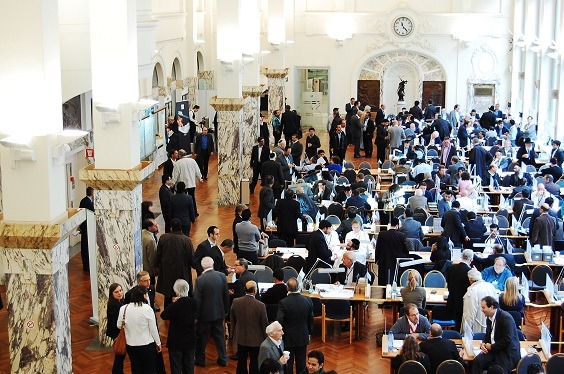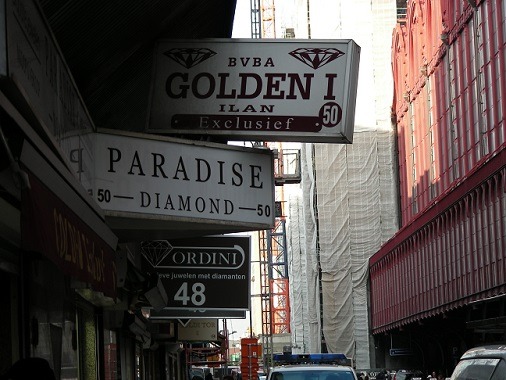Diamonds have been synonymous with Antwerp for centuries and have long been a jewel in Belgium’s economic crown. Even now it remains the largest diamond centre in the world. The Flemish city is a trading centre for 85 per cent of the world’s rough diamonds and around 50 per cent of the globe’s cut diamonds. This glittering industry accounts for 5 per cent of all Belgian exports and demand is higher than ever.
The diamond sector, a multi-billion euro industry, employs thousands of people in Antwerp from many nationalities. The city’s diamond quarter near the beautiful Central Station is the nerve centre of the trade. You will find many Hassidic Jews, Gujarati Indians, Russians, Lebanese and Chinese, to name but a few of the ethnic groups and nationalities, working as merchants, cutters, graders, insurers, bankers and diamond dealers in the unassuming buildings around Hoveniersstraat.
The street is also home to Antwerp’s main rough diamond bourse, the Antwerpsche Diamantkring, the beating heart of diamond trading in the city, where security is extremely tight. Visitors not only have to hand in their passports, but are fingerprinted before entering the building.
According to the Antwerp World Diamond Centre (AWDC), which regulates imports, exports and promotes the industry, the diamond trade overall was up by six per cent last year though the rough diamond trade continues to be the dominant force compared to its polished diamond counterpart.
To date, employment remains high and stable despite today’s technological boom, which has affected countless other sectors. Diamond cutting and polishing still requires the expertise of the human hand and eye to establish shape, colour and weight.
Further stability was introduced to the industry recently by the Belgian Government. A new so-called “Carat Tax law”, which will take effect this coming tax year, aims to aid registered diamond traders by removing the complexity of the profit-based tax system. The traders will no longer be taxed on profits but on a percentage of their overall turnover. It remains to be seen whether traders will end up paying more tax, but it has largely been welcomed by industry stalwarts, who believe Antwerp’s diamond future will forever be on solid ground.

The trading hall in Antwerp’s Diamond Bourse. The bourse was founded in 1904 to give traders and manufacturers a more secure and structured place to conduct business.
The future may look firm but what of Antwerp’s past? Why diamond encrusted roads led to Antwerp in the first place is not really known. It is thought that the city was the last port of call for the Asian trade to Europe. This was thanks to India, which was once the hub of the diamond trade long before mines were discovered in Africa and other parts of the world. Antwerp’s position on the River Scheldt’s Westerschelde estuary, lying just 80 kilometres or so from the sea, made it an accessible gateway in and out of Europe. Many fine craftsmen from all over the world came to Antwerp and made it their home, another reason the city became a popular choice for the industry.
Despite a period when Amsterdam briefly replaced Antwerp as Europe’s leading diamond trade centre and Bruges that, for a short spell, was the preferred destination on the Asian/European diamond trade route, Antwerp has always remained in poll position.
Antwerp’s links with diamonds go back as far as the 16th century, but trading was briefly interrupted during the Second World War when many of its precious gems were shipped to England for safekeeping to avoid Nazi control over the industry, which employed a large number of persecuted Jews. But it wasn’t plain sailing for Antwerp’s diamonds when they returned to the city as the diamond quarter was also the centre, in the post-war period, of criminal activity. What was then known as the “world’s biggest heist” took place in 2003, when around 100 million dollars worth of diamonds and gold was stolen from vaults in the diamond district. There have also been many anti-semitic attacks in the district. The most serious one took place in 1981, when a car bomb went off, killing three people.
Despite this, Antwerp has refused to give up its crown. Of course the law of supply and demand is playing its inevitable role, as the current demand is higher than ever while supplies cannot match the request. This imbalance means the price of just one 5-carat diamond can cost as much as 700,000 euro. Mines are often in inhospitable places, especially in some parts of Africa, which has led to research into producing synthetic diamonds. However, attempts have largely failed, and it is the real thing, which remains highly sought after. The rich and famous desire the precious stone, which sparkles like no other gem on earth, but its origins are just as dramatic as its appearance.
Diamonds, a carbon, are found in volcanic rock deep underground and take millions of years to form. They appear in a pipe substance called Kimberlite but hundreds of tonnes of rock may be unearthed before one tiny carat of diamond is found. There are around as many as 16,000 different categories of diamond, which can be white, yellow, blue, green or brown in appearance.
In stark contrast to the beauty of diamonds, ugly controversies often surround the industry, such as little or no human rights for diamond miners in some countries like Sierra Leone for example, a so-called “Blood Diamond” area of the world. But many traders in Antwerp have stressed that they only source diamonds from legitimate areas where workers are treated with respect by using the tracing process known in the trade as the Kimberley Process Certification Scheme.
“We source many of our diamonds from Africa, Canada and Australia, but we choose our diamond mines carefully,” said a spokesperson from Moppes DiamondLand in the city’s Appelmansstraat quarter. Representatives from Tiffany and Co., which has an established base in Antwerp, have voiced their concerns about human rights of workers in Angola and Mugabe-controlled Zimbabwe and are reluctant to source diamonds from these countries. This is a principled move partly in defiance – some think – of the lifting of a ban by the European Union on sales of diamonds from the Marange region of Zimbabwe to Europe.
Antwerp’s diamond industry’s road to riches has never been an easy one, but nevertheless it continues to fascinate. To celebrate its history, a grand exhibition has been planned for the Museum aan de Stroom (MAS) in the city’s port area this October. Whatever the future holds for Antwerp’s diamond industry, it has no doubt played a major role in Belgium’s history and economy, and will likely maintain this as the industry grows and the city remains the largest diamond trading centre in the world.
By Kim Clayton

